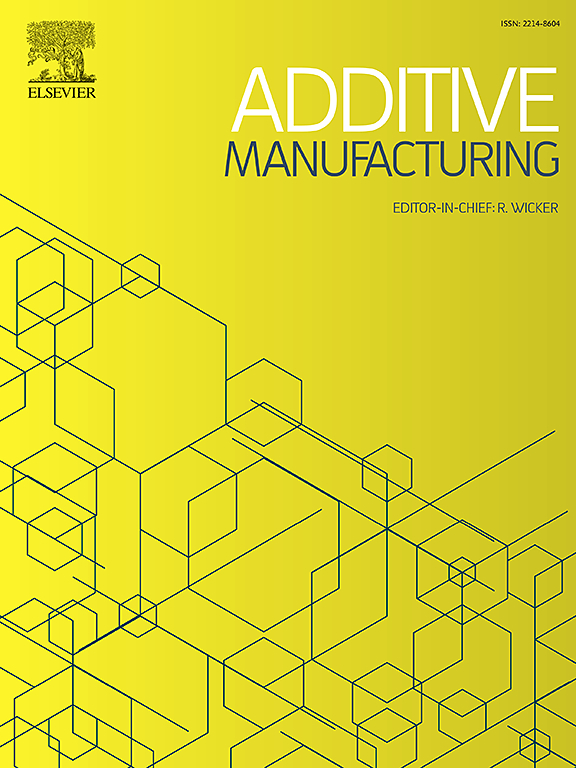Dissolution zone model of the oxide structure in additively manufactured dispersion-strengthened alloys
IF 10.3
1区 工程技术
Q1 ENGINEERING, MANUFACTURING
引用次数: 0
Abstract
The structural evolution of oxides in dispersion-strengthened superalloys during laser-powder bed fusion is considered in detail. Alloy chemistry and process parameter effects on oxide structure are assessed through a parameter study on the model alloy Ni-20Cr, doped with varying concentrations of Y2O3 and Al. Small angle neutron scattering measurements of the dispersoid size distribution show the dispersoid size increases with higher laser power, slower scan speed, and increasing Y2O3 and Al content. Complementary electron microscopy measurements reveal reactions between Y2O3 and Al, even in nanoscale dispersoids, and the presence of micron-scale oxide slag inclusions in select specimens. A scaling analysis of mass and momentum transport within the melt pool, presented here, establishes that diffusional structural evolution mechanisms dominate for nanoscale dispersoids, while fluid forces and advection become significant for larger slag inclusions. These findings are developed into a theory of dispersoid structural evolution, integrating quantitative models of diffusional processes – dispersoid dissolution, nucleation, growth, coarsening – with a reduced order model of time-temperature trajectories of fluid parcels within the melt pool. Calculations of the dispersoid size in single-pass melting reveal a zone in the center of the melt track in which the oxide feedstock fully dissolves. Within this zone the final Y2O3 size is independent of feedstock size and determined by nucleation and growth kinetics. If the dissolution zones of adjacent melt tracks overlap sufficiently with each other to dissolve large oxides, formed during printing or present in the powder feedstock, then the dispersoid structure throughout the build volume is homogeneous and matches that from a single pass within the dissolution zone. Gaps between adjacent dissolution zones result in oxide accumulation into larger slag inclusions. Predictions of final dispersoid size and slag formation using this dissolution zone model match the present experimental data and explain process-structure linkages speculated in the open literature.
增材制造弥散强化合金中氧化物结构的溶解带模型
详细研究了分散强化高温合金在激光-粉末床熔合过程中氧化物的结构演变。通过对模型合金Ni-20Cr中掺杂不同浓度的Y2O3和Al的参数研究,评估了合金的化学性质和工艺参数对氧化物结构的影响。小角中子散射测量表明,随着激光功率的增加、扫描速度的减慢以及Y2O3和Al含量的增加,弥散体尺寸增大。互补电子显微镜测量揭示了Y2O3和Al之间的反应,甚至在纳米级分散体中,以及在某些样品中存在微米级氧化渣夹杂物。本文提出的熔池内质量和动量输运的尺度分析表明,纳米级弥散体的扩散结构演化机制占主导地位,而流体力和平流对较大的渣包体起重要作用。这些发现被发展成弥散结构演化理论,将弥散溶解、成核、生长、粗化等扩散过程的定量模型与熔池内流体包块的时间-温度轨迹的降阶模型相结合。对单道熔炼分散体尺寸的计算表明,在熔炼轨迹的中心有一个区域,在这个区域中氧化物原料完全溶解。在此区域内,Y2O3的最终尺寸与原料尺寸无关,由成核和生长动力学决定。如果相邻熔体轨迹的溶解区彼此充分重叠,以溶解在印刷过程中形成的或存在于粉末原料中的大量氧化物,那么整个构建体积的分散结构是均匀的,并且与溶解区内单个通道的结构相匹配。相邻溶解带之间的间隙导致氧化物堆积成较大的渣包体。使用该溶解带模型预测的最终分散体尺寸和渣形成与目前的实验数据相匹配,并解释了公开文献中推测的过程-结构联系。
本文章由计算机程序翻译,如有差异,请以英文原文为准。
求助全文
约1分钟内获得全文
求助全文
来源期刊

Additive manufacturing
Materials Science-General Materials Science
CiteScore
19.80
自引率
12.70%
发文量
648
审稿时长
35 days
期刊介绍:
Additive Manufacturing stands as a peer-reviewed journal dedicated to delivering high-quality research papers and reviews in the field of additive manufacturing, serving both academia and industry leaders. The journal's objective is to recognize the innovative essence of additive manufacturing and its diverse applications, providing a comprehensive overview of current developments and future prospects.
The transformative potential of additive manufacturing technologies in product design and manufacturing is poised to disrupt traditional approaches. In response to this paradigm shift, a distinctive and comprehensive publication outlet was essential. Additive Manufacturing fulfills this need, offering a platform for engineers, materials scientists, and practitioners across academia and various industries to document and share innovations in these evolving technologies.
 求助内容:
求助内容: 应助结果提醒方式:
应助结果提醒方式:


